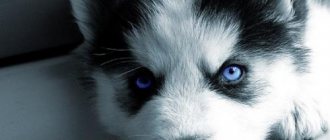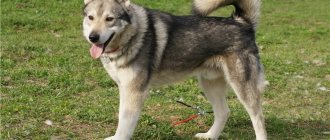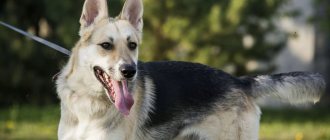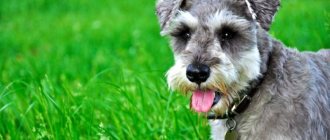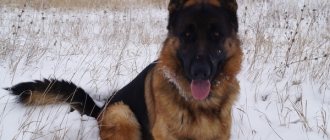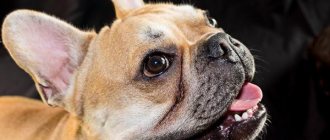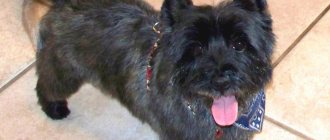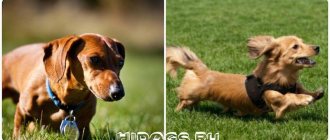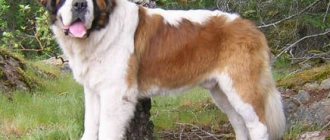As a result of selection, various colors of dogs have been created. There are so many of them that it's easy to get confused. Some breeds include many colors in the standard; predicting the appearance of one color or another is often difficult even for an experienced breeder. Knowing what colors dogs come in will help you distinguish a rare breed color from a breeding defect.
Diversity in the Spitz breed
What is color and suit in dogs
The coat color is the color of a dog's coat. Color is one of the characteristics of the breed, and a pet with a color deviating from the standard will receive a low rating at the show or will be disqualified.
Colors can be simple - one-color, and complex - two- and three-color. The tone of the hair is determined by two pigments - black and red-yellow, which can be expressed with different intensities or not expressed at all. The absence of pigment makes the dog white.
Note! The absence of pigment may indicate the possible presence of certain diseases, for example, a tendency to allergies and hearing problems.
Coat pattern is an inherited trait, passed on from the pet's parents in different forms.
Genetics
The color of a dog depends on a number of genes, their combinations and clarity of expression. So, a black dog can be of any color that overlaps the gene for excessive black coloration. And when crossing two black dogs, it is possible that any breed color may appear in the puppies.
All dogs at the beginning of selection had the so-called wolf or zonular color. With this coloring, the color of the hair changes along its length, and the overall pattern is darker on the back. Zonal coloration provides camouflage in any conditions.
Wolf color in a German Shepherd
In addition to coloring, coat pattern also depends on genes. In embryonic development, the pet is colored from top to bottom, starting from the back and ending with the tips of the limbs. Due to the specifics of the formation of the pet’s head from the neural tube, the head and chest stand apart, which are also painted relatively late.
One of the common defects in puppies is the appearance of white spots on the paws, tip of the tail or chest. Such pets should be excluded from further breeding. The color and type of coat, pattern are signs of the breed. Understanding the breed standard will help you avoid buying a defective puppy and predict some health problems.
How does a dog's color affect its character?
Brindle dog
Some people choose a pet based on the color of its coat in order to professionally breed a rare breed in the future, while others pay so much attention to the coat color only because they believe that it affects the character of the dog. We do not undertake to say that this is not so. Therefore, we give you a brief description of what color dogs have what character.
- Dogs that do not have a clearly defined color (light eyes, no black eyeliner around the eyes, light nose) have problems with the nervous system and health.
- Dark-colored dogs are independent, self-sufficient, difficult to train and educate, prone to dominance, restrained in showing emotions, however, extremely responsible in terms of fulfilling the security duties assigned to them. It is difficult to find a common language with such dogs and they constantly need to prove who is boss.
- The red color of a dog symbolizes that the animal is open, affectionate and emotional, its cunning borders on extreme simplicity, and even if the dog does a mischief, it will do it not out of harm, but to entertain you. Such dogs must be taught the “come to me” command, since, if they become interested in something during a walk, they can simply run away from you. By the way, owners of red dogs note their vocality - the dogs bark, howl, whine, in a word, they express all their emotions with the help of their voice.
- Animals of brindle color have a mixed type of character - they have the seriousness of black dogs and the openness of red dogs. As a rule, they are conflict-free, phlegmatic and balanced. They make good guards. True, some of their slowness during the execution of commands can irritate the owner, but it is necessary to understand that the dog, due to the peculiarities of its temperament, simply cannot work faster.
- Light and white colors are signs of aristocracy, with all the ensuing consequences. Animals are nervous, capricious, love to be the center of attention, mischievous, stubborn, it is quite difficult to work with them, however, white color is considered to be “commercial” and such puppies are sorted out first. True, then the owner of a white pet may understand that it is not so easy with him. But beauty, as you know, requires sacrifice...
And, although how a dog will behave in your home (read about the features of its adaptation here) is influenced by how you raise it and in what conditions you will keep it, discount the fact that its color also affects her character and temperament are not worth it.
Video about the colors of our four-legged friends:
Why do you need to know the type of coat, color and color of the dog?
The structure of individual hairs differs among different breeds. Coat characteristics are a sign of compliance with the breed standard. Main types of dog fur:
- Wild – straight guard hairs and undercoat are present. Most working breeds have this type of coat. For example, a husky or a corgi.
- Short-haired. Short straight coat without undercoat. Examples of short-haired breeds are the Jack Russell Terrier and the French Bulldog.
- Long-haired. The guard hair is long and silky, especially on the “mane” along the lower part of the tail. The presence of undercoat depends on the breed. Examples are Russian and Cocker Spaniel, Labrador Retriever.
- Wirehaired. The guard hair is hard and sticking out. The undercoat is pronounced. There are wire-haired varieties of dachshunds.
In addition, dogs are divided into shedding and non-shedding dogs. Non-shedding pets have a hair structure and growth patterns similar to humans, so they do not shed annually, but their fur grows constantly. Such dogs definitely need haircuts and regular brushing.
Guard hairs can be straight or wavy. Wavy ones are found in poodles, straight ones are found in collies. Breeds are not limited to such variants; many intermediate variants have been developed through selection. For example, hairless or corded dogs.
Understanding coat types will allow you to choose the dog that is most comfortable to care for. The undercoat makes the dog more resistant to low temperatures, curly hair is difficult to care for, and non-shedding dogs require regular brushing. Dogs without hair are prone to missing teeth; this may be in the breed standard or considered a defect.
On a note! The type of coat, as a rule, does not directly affect the health of the pet, but requires different care, which must be taken into account when choosing a breed. The exception will be white dogs, which are predisposed to a number of diseases.
English Setter. Gun dogs
If areas of the body with hair devoid of pigment are so large that they form the main background of the color, and the pigmented hair is located in separate spots, the color is called “spotty”.
The disappearance of pigment - depigmentation - usually begins in strictly defined areas of the dog's skin. Professor of Moscow University K.F. Roulier established the following pattern of this phenomenon: each point of depigmentation occurs independently and is isolated. Subsequently, when cultivating similar animals, the depigmented area in the offspring increases and the points of depigmentation merge, forming large white areas. Sometimes these areas develop so strongly that they become depigmented
places remain only in the form of individual spots. The dog, in addition to points of depigmentation, has the most stable pigmented centers, indicated by Charles Darwin. This is the area of the eyes, ears, base of the tail and certain areas of the back. Piebald color, usually mixed with spotted. The main color for piebaldness is dark: red, black, zone-gray, etc. At the points of depigmentation, white pinches appear, which merge and form a white stripe - a blaze - from the nose to the forehead or occipital protuberance, dividing the head into two parts; white neck, merging with the white chest and belly; white legs; the front ones up to the pastern or elbow joint, and the rear ones up to the hock joints; white end of the tail. White dogs lack pigment in their hair, but have a pigmented black or brown nose and colored irises. This is observed in many dog breeds. Animals that have absolutely no pigment in their bodies, complete albinos, are unknown among dogs. Black color is found in its pure form, and most often with white spots, although of insignificant size, or with brown, brown or gray markings. The red color varies in its shades: red-red (characteristic of the red setter), bright red with darker hair on the head, neck, back and upper side of the tail; lighter on the larynx, chest, sides and limbs; light red, often called yellow. Golden-red color with a reddish tint at the end of the hair, uniform throughout the body, often with a dark, sometimes even black muzzle - a “mask”. Fawn color is a kind of weakened red color, reminiscent of the color of sand, and also comes in different shades. The legs, chest and lower part of the tail of dogs of this color are almost white. Often with a dark, sometimes even black mask. Brown color, or, as it is sometimes called, coffee. The saddle color consists of two colors: the main one - red of any shade - from light fawn to bright red and a gray or black saddle blanket, as if covering the dog (saddle blanket). Black hair, starting from the head, covers the bridge of the nose, forehead, ears, neck, back, shoulders, hips and the upper side of the tail. Accordingly, the lower part of the head, lower jaw, cheekbones, larynx, chest, belly, legs and underside of the tail are light in color. The size of the saddle cloth and the tone of its color are different. Sometimes it starts from the neck, leaving the head light; in some cases it covers only the upper part of the shoulders and hips or reaches the very legs; in other cases it does not cover the upper side of the tail, leaving it light, etc. It can be black, gray, brown, sharply demarcated from a light tone or gradually merging with it. The black-and-white color finally appears only after the puppy's hair changes. Black-and-tan puppies are usually black and tan, and the hair on their heads, legs, and sides becomes lighter as they age. Tan dogs can have a different base tone - black, brown, gray. They are characterized by tan marks - light marks compared to the main color, which, unlike the saddle color, have a constant, regular pattern. The tan marks are sharply demarcated from the main color and are located in the form of two spots - “eyebrows” above the eyes, on the muzzle, with the exception of the bridge of the nose, on the cheekbones and larynx; two spots on the chest in the form of triangles facing each other; cover the front legs up to the pastern and the hind legs, from the front side to the hock joint, forming a spot around the anus and on the underside at the root of the tail. The zone-gray color is known as wolf color and is characterized by the fact that the hair in this case has a light band devoid of pigmentation, as if dividing it into several zones. The hair of a zone-gray dog has a light base, then a black zone, then a light, usually yellow zone and a black end, or it can be light with a black end. Permanent color appears in zonular dogs only after the puppy's downy hair is replaced. Light gray puppies have a dark stripe along their backs. In addition to the zone-gray color, it can also be zone-red. A zone-gray dog with brown and black hair is called a brown dog. The blue color, more precisely gray, reminiscent of the color of a mouse, comes in two tones: light ash and dark, almost black. This color is rarely found in its pure form and, like black, is almost always accompanied by white spots on the chest and legs. Tiger color. On a yellow, brown or gray background, the dog is covered with dark transverse stripes, reminiscent of the color of a tiger. The correct brindle color should have a golden or light brown background, on which bright, intensely colored rings are located in regular rings, connecting on the back and chest and disappearing in the groin area, as well as the same rings on the legs and tail. Deviations encountered include a dim background and faint stripes, which often do not form rings, but are barely noticeable, then partially merging with the main background. Most brindle dogs have a dark "mask", which is considered desirable. With the brindle color there are white markings. Marble color (harlequin) is characterized by a white or light background, on which individual small irregularly shaped black or brown-gray spots are scattered. Large dark spots are not typical.
A.P. Mazover Photo by I.I. Pozharova
Color groups
Coat color can be:
- solid or one color;
- mixed or two and three colors;
- modified.
The pattern and severity of unpainted areas are breed characteristics.
Solid color
No color transitions. The pet is one color. It can be white, cream, gray, red, brown and so on. This includes any possible combination of black, red and complete absence of pigment.
This is interesting! In rare cases, there are red dogs.
Mixed
The key feature of this color is the absence of a white tone. The combinations are as follows: the color is red and the muzzle is black; red with shades, brindle, black with red tan, saddleback.
Modified
Changes in pattern and color intensity depending on the age of the dog or due to breed characteristics. An example of a breed with a modified color is the Bedlington Terrier, which becomes lighter in color as it transitions from puppy to adult dog.
On a note! Marble color and any color with white, unpainted zones are also modified.
Do dogs change coat color throughout their lives?
Those who choose a four-legged friend based on criteria such as color should know that representatives of some dog breeds change coat color with age. You can read about other age-related changes that occur in dogs' bodies here. So, for example, dogs of a breed such as the Kerry Blue Terrier do not acquire the blue coat color characteristic of their breed until they become adults. And, here are other breeds of dogs - on the contrary, their blue-black color changes to gray with age. Therefore, choosing a puppy and focusing only on its childish color is not entirely correct.
If you need a show dog, and you do not want to doubt the correctness of its breed color in the future, in this case it is worth buying an adult animal. Then, the choice of a puppy is always accompanied by possible surprises with its adult coat color.
Varieties
According to the fur pattern, the animal can be one color, for example, a gray dog, or multi-colored. The most common breeds are two-colored. Bi-colored dogs have coat pattern names that differ between breeds, but are genetically identical.
Different breeds have different names for colors, which often causes confusion. Thus, the zone color of Giant Schnauzers is called “salt and pepper”, and the tri-colored Spitz will be called “patty”. Difficulties are also caused by inaccuracies in the translation of names.
Zonar
The most natural coloring of a dog. Found in German Shepherds and Laikas. There are any colors with darkening, when part of the hair is painted a darker color. A rare variety of zone color is brindle.
Cheprachny
So named because of its resemblance to a saddle blanket - a blanket for horses. The sable coloring looks as if the dog was covered with a dark blanket on top. It is most common in German Shepherds and VEOs.
German Shepherd with saddle blanket
Tan
From a genetic point of view, the tan color of a dog is a more pronounced type of saddle coat. Light areas remain on the tips of the paws, chest and certain areas of the muzzle. Tan color is inherent in many breeds: Rottweilers, Dobermans, Dachshunds, Chihuahuas, Toy Terriers.
Tanned by a Rottweiler
Murugiya
This color is also called sable or deer. As a rule, this is red hair, and the ends are darker. The murugo color is characterized by dark areas on the back and top of the neck. It is found in many breeds: St. Bernards, Spitz, Chow Chow.
Sable color in a greyhound
Tricolor
Many breeds can have a tri-color color. It may include splashes of white, or white will be the main color.
Miniature Schnauzer colors: brown and chocolate-tan
Schnauzers with brown pigment have been born in litters throughout the history of the Schnauzer and Pinscher breeds. Initially, these breeds were bred as one and in German stud books there are regular references to the birth of brown puppies. A little later, when a sufficient number of “stable pinschers” had been accumulated, the breed was divided into two. Smooth-haired dogs remained pinschers, and their bearded relatives began to be called schnauzers in honor of one Schnauzer (this was the nickname of the bearded pinscher, meaning “face, face dog”), who was such a remarkable dog that his nickname became the name of the whole breed. Among Pinschers, the chocolate and tan coloring was preserved in the Doberman breed (at one time it was also a Doberman Pinscher). Dogs of this color have always been distinguished by their bones and excellent health.
The first official mention of the chocolate and tan color, split from two black and silver dogs, was in 1994. Such miniature schnauzer puppies began to appear in Czechoslovakia, as was reported to colleagues by the president of the miniature schnauzer club, Zdena Vanisova, a breeder with twenty years of experience. In Russia, the first “chocolate bars” were born in the same year, 1994. But since only males were born at first, this fact was not developed. BUT in 1997 several females of this color were born at once and it received the name – chocolate and tan.
From a genetic point of view, it would be more correct to call the chocolate and tan color brown and tan with silver, since this name most fully reflects its genetic nature. All modern chocolate miniature schnauzers in Russia descended from a black and silver chocolate bearer, an imported male Dik Vechny Rival, that was once brought to the Santa Kniris kennel. The first chocolates were born in inbreeding to him and to this day all dogs of this color in the distant generations of the pedigree have this male. There are also brown miniature schnauzer (without silver) and the so-called red pepper with salt. However, only black and silver miniature schnauzers took part in the breeding of chocolate and tan.
There are three ways to obtain chocolate miniature schnauzers.
- Mating of two chocolate dogs. The entire litter in this case is born chocolate and tan. In such litters it is especially noticeable that within the color there are color variations determined by different chocolate genes. There are dogs of a dark, cool tone - the so-called “bitter chocolate”, a warm tone, called “milk chocolate” and intermediate variations. The depth of the silver markings and their color may also vary.
- Mating of a chocolate and tan dog and a black and silver carrier of the chocolate gene. Such a cross is called an analyzing cross, since it makes it possible to find out whether the black and silver miniature schnauzer is a carrier of the chocolate gene. In this case, half of the litter will be born black and silver, and the other half will be chocolate and tan. All black and silver dogs from this mating are carriers of the chocolate and tan color.
- Mating of two black and silver miniature schnauzers, each of which is a carrier of the brown gene. This mating results in a classic Mendelian uncoupling - one quarter of the dogs will be black and silver without the brown gene, one quarter will be chocolate and tan dogs, and half will be black and silver carriers. When using black and silver dogs from such a litter for breeding, they should be genetically tested for the presence of brown genes.
Among the characteristics for which the type of inheritance has not been established are the tone and intensity of the color, the shade of cream on the tan and the overall brightness of the color.
For the first time, chocolate and tan miniature schnauzers were admitted to exhibitions in Russia in 2006. This became the impetus for the popularization of color. Previously, such dogs were concentrated beyond the Urals and in Moscow. Their appearance at exhibitions caused the increase in popularity of the color; dogs began to be bred in Ukraine, Finland, the Czech Republic, and the USA. The use of the best black-and-silver sires in breeding made it possible to quickly make the exterior of the dogs more modern and increase the amount of decorative fur. Color lovers showed their dogs at specialty shows, as well as at major international shows. A breed standard for the chocolate and tan miniature schnauzer has been developed.
However, soon breeding of the color was prohibited by RKF functionaries. Dogs began to be given pedigrees without the right to breed, thereby destroying the painstaking work of breeders of this color for more than 15 years. Only in Ukraine, chocolate miniature schnauzers achieved the right to breed in one of the alternative organizations, preserving their full pedigrees.
Currently, these dogs are bred in Russia without documents. However, dogs of this color remain in all major databases of purebred miniature schnauzers and work to preserve information about the origin does not stop.
You can often hear that the color of chocolates is allegedly linked to genes for hereditary diseases. However, all such statements are not supported by any statistical data. Many chocolate dogs excel at catching rats, in addition, they have excellent health and live up to 17 years. The frequency of eye diseases in color is not higher than that in miniature schnauzers of standard colors.
The experience of American breeders who breed miniature schnauzers of all color varieties, including pure chocolate and chocolate-tan, is interesting.
Despite the differences in type, American-bred dogs are successfully used as breeders and a possible option for chocolate miniature schnauzers to obtain official pedigrees is their entry into the AKC. The good news is that despite the existing obstacles, color enthusiasts continue their work. The birth of chocolate and tan puppies is monitored, and breeding dogs are exchanged in order to expand the breeding base. chocolates at alternative exhibitions confirm their breed and the correct direction of breeding work. The high level of professionalism and cleanliness of the color breeders give hope for its revival and appearance among the standard colors of the miniature schnauzer.
Unusual shades
Each breed has its own rare colors. In general, brindle and piebald colors are rare.
Brindle is named for the similarity of the dog's color to the color of the tiger's skin. It has strict requirements for the expression of lines.
Brindle color
Piebald or roan coloring is typical for hunting breeds, such as shorthaired pointers. Externally, it is recognizable by the presence of frequent small spots on its fur.
On a note! An unusual color is usually a color that is not included in the breed standard. This can be a generally accepted standard, or sudden and funny coloring elements. Dogs with these appearance characteristics make good pets, but should be excluded from breeding.
Spotted color (brindle)
Brindle coloring characterizes dogs with dark stripes on a light background, which is determined by the presence of two pigments. They have the same “mixed” character - partly from black and partly from red breeds.
Tiger individuals combine the best character traits of their black and red counterparts. They are balanced, phlegmatic, open and responsible. These dogs are loyal guards, but are very slow. Their phlegmatic nature often hinders training.
Representatives of tiger breeds are Kai Inu, German Boxer, and Tiger Akita.
